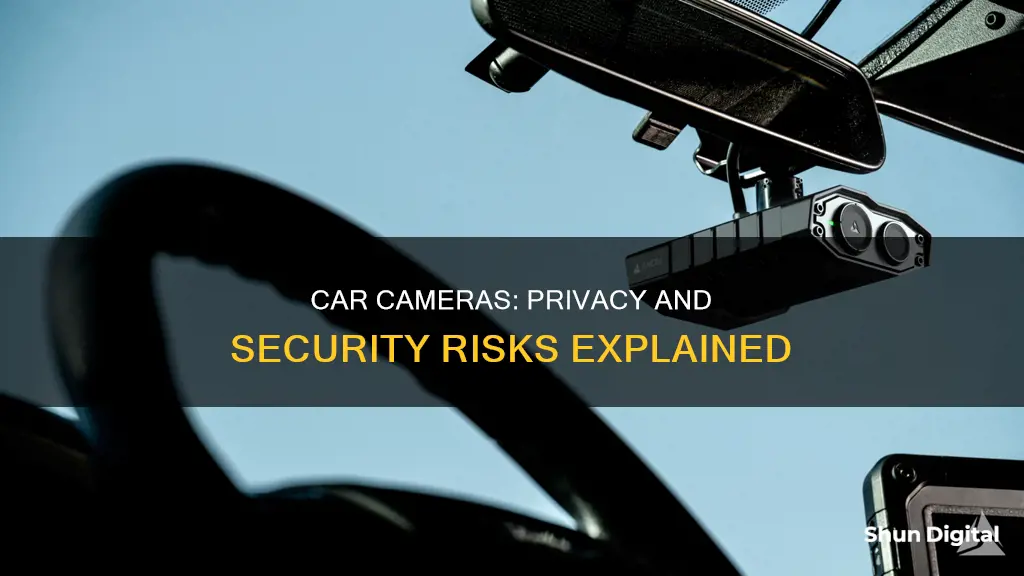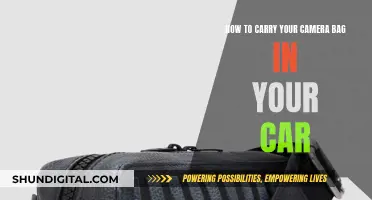
Cameras are sensitive pieces of equipment, and their exposure to extreme heat can lead to costly damage. The internal components of a camera can be damaged by high temperatures, and the exterior finish can be affected by long-term exposure to UV rays. While some cameras have a higher temperature rating than others, it is generally not advisable to leave your camera in a hot car. If you must leave your camera in your car, there are several steps you can take to mitigate the risk of damage, such as keeping it in a gear bag, using a cooler, and covering it with a light-coloured cloth or towel.
| Characteristics | Values |
|---|---|
| Safe temperature range for cameras | 0-45°C (32-113°F) |
| Safe temperature range for Canon EOS 1Ds Mark III | up to 45°C |
| Safe temperature range for Hasselblad X1D-50C | up to 50°C |
| Safe temperature range for HP Photosmart R967 | up to 50°C |
| Safe temperature range for Nikon cameras | 0-40°C |
| Temperature inside a car on a 100°F day | 130-180°F |
| Temperature inside a car trunk on a 100°F day | 105-110°F |
| Risk of camera overheating in a car | High |
| Risk of camera theft from a car | High |
What You'll Learn

Heat damage to camera parts
Heat damage to a camera's components depends on several factors, including the duration of exposure, the camera's materials, and the specific parts' heat tolerance. Here are some insights into how heat can affect camera parts:
- Sensors and Electronics: Sensors are highly heat-sensitive, and prolonged exposure to extreme temperatures can damage them. This may result in increased sensor noise in captured images. Electronics, in general, do not fare well under prolonged heat exposure, and their performance can deteriorate.
- Lenses: Lenses may be affected by heat, especially if they are made of plastic. Extreme heat can potentially warp or melt plastic lenses, although this is unlikely with short-term exposure. Glass lenses are generally more resistant to heat damage but can still be affected by extreme temperatures.
- Exterior Finish: Prolonged exposure to direct sunlight and high temperatures can cause the exterior finish of a camera to fade and become brittle over time. This can affect the cosmetic appearance of the camera and potentially impact its durability.
- Film: Film can be particularly sensitive to heat. While it may not be ruined by short-term heat exposure, long periods of exposure to high temperatures can affect the film's quality. This can result in muted colours, reduced contrast, and an overall decrease in image quality.
- Other Parts: Other camera components, such as the shutter mechanism, focus motors, and internal circuitry, may also be susceptible to heat damage. While they may not be as heat-sensitive as sensors, prolonged exposure to extreme temperatures can affect their performance and increase the risk of malfunction.
To minimise the potential for heat damage, it is recommended to avoid leaving cameras in direct sunlight or in extremely hot environments for extended periods. Allowing the camera to cool down gradually before use and storing it in a well-ventilated area can also help prevent heat-related issues. Additionally, using protective cases or bags can provide some insulation against extreme temperatures.
Hacking Risks: Webcam Security and Privacy Concerns
You may want to see also

Long-term exposure to UV
Keeping a camera in a car for a long period can cause damage due to long-term exposure to UV rays. While car windows generally block UVB rays, they don't block UVA rays, which can cause tanning, skin ageing, wrinkles, and sunburn. Over time, exposure to these rays can lead to skin cancer.
The intensity of UV exposure in a car depends on various factors, such as the type of car glass and whether the windows are open or closed. Studies have shown that UV wavelengths longer than 335 nm can be transmitted through car windows, and UV irradiation above 380 nm can pass through compound glass windscreens. On the arms, UV exposure was found to be 3-4% of ambient radiation when the car windows were closed and 25-31% when the windows were open.
To reduce UV exposure in a car, it is recommended to keep the windows closed, especially on sunny days. Additionally, using protective measures such as plastic films, clothing, or sunscreens can provide extra protection from UV rays.
Understanding Raw Camera Mode: Unlocking Photography Potential
You may want to see also

Camera theft
To prevent camera theft, photographers often invest in locking theft-resistant bags that can be locked to the inside of the car. Some photographers also choose to get insurance for their equipment, although one source notes that many insurance companies do not cover cameras in unattended cars.
In addition to the risk of theft, leaving camera equipment in a hot car can also damage the cameras and lenses due to the high temperatures and direct sunlight. To mitigate this, photographers can use a sun shade on the windshield and crack the windows to keep the car slightly cooler. Placing cameras in a bag on the floor or under a seat, away from direct sunlight, can also help prevent heat damage.
Unlock Snapchat's Night Camera Mode: A Step-by-Step Guide
You may want to see also

Condensation
- Acclimation is key. When moving between environments with drastic temperature differences, ensure your camera is securely stored in your camera bag with all zippers closed. The padding in the bag acts as insulation, helping to regulate sharp temperature changes and allowing your gear to acclimate slowly. Depending on the temperature difference and the size of your gear, you may need to leave your camera in the bag for several hours to fully acclimate.
- For extra protection, place your camera inside a plastic ziplock bag before stepping into a new environment with different temperature or humidity levels. This provides an additional layer of protection and prevents the new air temperature from directly hitting your camera.
- If condensation has already formed on your camera, do not wipe the lens as it will leave streaks. Instead, place your camera in an airtight bag and remove as much air as possible. You can also put something in the bag to wick moisture away, such as a towel or uncooked rice. Wait until the camera reaches the same temperature as the surrounding environment and all condensation has dissipated.
- If your lens is foggy, try warming your camera equipment gradually. You can turn on the heater in your vehicle or use a hairdryer on low heat. Be careful not to concentrate the heat on one spot.
- Use silica gel packets or dehumidifiers to absorb moisture. Place your camera inside your camera bag with a few silica gel packets near the camera and lens. You can also use a Hydrosorbent silica dehumidifier tin, which is designed to protect enclosed spaces from moisture.
- Keep your camera warm, especially in cold environments, to prevent condensation. You can use a waterproof cover, such as the Camera Duck All Weather Cover, which has internal pockets for air-activated heat packets.
- Allow your camera gear to acclimatise when moving between environments with drastic temperature differences. Place your gear inside your camera bag and ensure all zippers are closed, providing insulation and helping to regulate temperature changes. Depending on the temperature differences, you may need to leave your gear in the bag for a few hours to fully acclimatise.
Canadian Police Cars: Are On-Board Cameras Standard?
You may want to see also

High temperatures in car trunks
The inside of a car can get very hot during the summer. The cabin of most cars can reach temperatures of up to 160ºF/71ºC when the outside temperature is around 100ºF/38ºC. This is due to the sun's energy passing through the windows and becoming trapped inside the car due to a lack of airflow.
The trunk of a car will also get hot, but it generally won't get as hot as the cabin area. This is because the trunk doesn't have any windows, so the sun's heat won't penetrate as much. The temperature in the trunk can still reach 130 to 150 degrees Fahrenheit when the car is parked in direct sunlight with outside temperatures of 80 to 95 degrees Fahrenheit. The trunk's temperature will also depend on factors such as the volume of the trunk, ventilation, paint colour, and the materials used in its construction.
To minimise the temperature increase in the trunk, it is recommended to keep the windows of the car slightly open to allow hot air to circulate out of the car. Keeping reflectors along the windscreen and using a car sunshade can also help to control the heat in the trunk by reflecting sunlight away.
High temperatures can affect sensitive camera equipment. Most cameras are rated for temperatures between 32F to 104F, and prolonged exposure to higher temperatures can potentially damage the camera's delicate parts. Therefore, it is recommended to store cameras in a protective bag or case and to allow them to cool down before use if they have been in an extremely hot environment.
Coach Camera Bags: History and Evolution
You may want to see also
Frequently asked questions
No, it is not safe to keep a camera in a car during hot weather. The inside of a car can get very hot, and even with cracked windows, the heat builds up fast. This can damage some of the most delicate parts of your camera.
The internal components of a camera can be damaged by the heat. The lubricants for the aperture blades in a lens can melt, causing the blades to stick together and malfunction. This can be costly to fix.
If you have to leave your camera in the car, there are a few things you can do to mitigate the risk of heat damage:
- Park in the shade or cover your car with a light-coloured sheet to create your own shade.
- Keep your camera in a gear bag or wrap it in a thick white towel to hide it from view and protect it from the sun.
- Add a cooler to your car (without ice) and drape a white towel over it.







